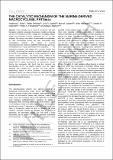Files in this item
The catalytic mechanism of the marine-derived macrocyclase PatGmac
Item metadata
| dc.contributor.author | Brás, Natércia F. | |
| dc.contributor.author | Ferreira, Pedro | |
| dc.contributor.author | Calixto, Ana R. | |
| dc.contributor.author | Jaspars, Marcel | |
| dc.contributor.author | Houssen, Wael | |
| dc.contributor.author | Naismith, Jim | |
| dc.contributor.author | Fernandes, Pedro A. | |
| dc.contributor.author | Ramos, Maria J. | |
| dc.date.accessioned | 2017-07-08T23:34:03Z | |
| dc.date.available | 2017-07-08T23:34:03Z | |
| dc.date.issued | 2016-09-01 | |
| dc.identifier | 244261673 | |
| dc.identifier | 569b09ea-1500-490c-981a-c780dafb3755 | |
| dc.identifier | 84978200124 | |
| dc.identifier | 000383763200022 | |
| dc.identifier.citation | Brás , N F , Ferreira , P , Calixto , A R , Jaspars , M , Houssen , W , Naismith , J , Fernandes , P A & Ramos , M J 2016 , ' The catalytic mechanism of the marine-derived macrocyclase PatGmac ' , Chemistry - A European Journal , vol. 22 , no. 37 , pp. 13089–13097 . https://doi.org/10.1002/chem.201601670 | en |
| dc.identifier.issn | 1521-3765 | |
| dc.identifier.other | Bibtex: urn:0d84a02eca7ce5c25c4a75b72af7a54d | |
| dc.identifier.uri | https://hdl.handle.net/10023/11170 | |
| dc.description | This work received financial support from the European Union (FEDER funds through COMPETE) and National Funds (Fundação para a Ciência e Tecnologia, FCT) through Projects EXCL/QEQ-COM/0394/2012, EXCL-II/QEQ-COM/0394/2012, and Pest-C/EQB/LA0006/2013. N.F.B. would like to thank the FCT for her IF starting grant (IF/01355/2014). | en |
| dc.description.abstract | Cyclic peptides are a class of compounds with high therapeutic potential, possessing bioactivities including antitumor and antiviral (including anti-HIV). Despite their desirability, efficient design and production of these compounds has not been achieved to date. The catalytic mechanism of patellamide macrocyclization by the PatG macrocyclase domain has been computationally investigated by using quantum mechanics/molecular mechanics methodology, specifically ONIOM(M06/6-311++G(2d,2p):ff94//B3LYP/6-31G(d):ff94). The mechanism proposed herein begins with a proton transfer from Ser783 to His 618 and from the latter to Asp548. Nucleophilic attack of Ser783 on the substrate leads to the formation of an acyl–enzyme covalent complex. The leaving group Ala-Tyr-Asp-Gly (AYDG) of the substrate is protonated by the substrate's N terminus, leading to the breakage of the P1−P1′ bond. Finally, the substrate's N terminus attacks the P1 residue, decomposing the acyl–enzyme complex forming the macrocycle. The formation and decomposition of the acyl–enzyme complex have the highest activation free energies (21.1 kcal mol−1 and 19.8 kcal mol−1 respectively), typical of serine proteases. Understanding the mechanism behind the macrocyclization of patellamides will be important to the application of the enzymes in the pharmaceutical and biotechnological industries. | |
| dc.format.extent | 1891696 | |
| dc.format.extent | 316286 | |
| dc.language.iso | eng | |
| dc.relation.ispartof | Chemistry - A European Journal | en |
| dc.subject | Cyclization | en |
| dc.subject | Molecular mechanics | en |
| dc.subject | Peptides | en |
| dc.subject | Quantum mechanics | en |
| dc.subject | Reaction mechanisms | en |
| dc.subject | QD Chemistry | en |
| dc.subject | NDAS | en |
| dc.subject | SDG 3 - Good Health and Well-being | en |
| dc.subject | SDG 14 - Life Below Water | en |
| dc.subject.lcc | QD | en |
| dc.title | The catalytic mechanism of the marine-derived macrocyclase PatGmac | en |
| dc.type | Journal article | en |
| dc.contributor.sponsor | BBSRC | en |
| dc.contributor.institution | University of St Andrews. School of Chemistry | en |
| dc.contributor.institution | University of St Andrews. EaSTCHEM | en |
| dc.contributor.institution | University of St Andrews. Biomedical Sciences Research Complex | en |
| dc.identifier.doi | https://doi.org/10.1002/chem.201601670 | |
| dc.description.status | Peer reviewed | en |
| dc.date.embargoedUntil | 2017-07-08 | |
| dc.identifier.grantnumber | BB/K015508/1 | en |
This item appears in the following Collection(s)
Items in the St Andrews Research Repository are protected by copyright, with all rights reserved, unless otherwise indicated.


